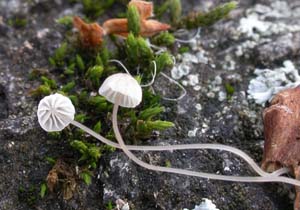On moss-covered trunks of
deciduous trees, or on fallen twigs and litter of various
trees, both deciduous trees and conifers. Often found among needles under Juniperus communis. One single specimen of a perfectely
white form was collected by A. Aronsen on grass near a beach
in Vestfold (Maas Geesteranus, 1991b: 550). Summer to late autumn. Locally quite common but probably overlooked. In Norway widespread in southern parts but also recorded north to Finnmark.
Pileus 2-7 mm
across, hemispherical, conical to parabolical, often more
or less depressed in the centre, and sometimes with a small
papilla, sulcate, translucent-striate, pruinose, glabrescent,
fairly dark brown at the centre, paler brown or grey-brown
towards the margin, or pale grey to whitish, paler to almost
white towards the margin, sometimes entirely white (see remark). Lamellae
9-15(-17) reaching the stipe, ascending, narrowly to more
broadly adnate, with or without a short tooth, pale grey
to whitish, occasionally somewhat intervenose, the edge
convex. Stipe 10-35 x 0.2-0.5 mm,
hollow, terete, equal, curved or flexuous, entirely pruinose
or minutely puberulous, glabrescent, shiny, whitish to grey
above, greyish to dark brown below, sometimes entirely white, the base covered with
or fastened to the substratum by long, white fibrils. Odour
none.
Basidia
18-24 x 6-9 μm, clavate, mostly 2-spored, but some
1-spored, with plump sterigmata up to 11 μm long.
Spores
9.2-12.2 x 4.5-6.5 μm, Q 1.3-2.5, Qav ~ 1.9, elongated pip-shaped, almost cylindrical,
smooth, amyloid. Cheilocystidia
15-30 x 8.5-22 μm, making the lamellar edge a sterile
band, clavate to obpyriform, densely covered with cylindrical
excrescences 0.5-4 x 0.5-1 μm. Pleurocystidia
absent. Hyphae of
the pileipellis 2-10 μm wide,
densely covered with warts or short cylindrical
excrescences. Hyphae
of the cortical layer of the stipe 1.5-4 μm wide,
fairly sparsely covered with cylindrical excrescences0.5-3 x 0.8-1.5 μm, terminal cells little differentiated, diverticulate, at the base of stipe appearing as caulocystidia 4-12 μm wide, clavate, diverticulate. Clamp connections present in all tissues.
Mycena mirata belongs to sect. Filipedes. Its characterizing features are the
small size, the small number of lamellae reaching the stipe,
the hyphae of the pileipellis, which are densely covered
with warts, the 2-spored or 1-spored basidia, the elongated
shape of the spores, and the presence of clamp connections.
In the literature M. mirata is only
described as 2-spored, and all my own collections have been
2-spored. A collection made by M. Krikorev, Sweden, however,
proved to have 4-spored basidia.
Sometimes perfectly white specimens of M. mirata can be encountered, especially when they grow on litter among fallen leaves and more or less covered by the leaves, typically under Salix caprea. Then it can be mistaken for Mycena terena, a species with smooth cheilocystidia.
Microphotos of cheilocystidia
 Go to sect. Filipedes.
Go to sect. Filipedes.
Further images on the web:
Mycologie
en Catalogne nord
|